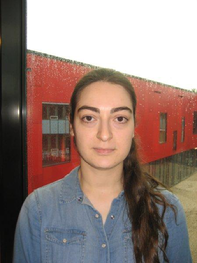Measuring adhesion forces between hydrophilic surfaces with atomic force microscopy using flat tips
Promotion date: June 28.
Promotor: Prof.dr.ir Harold Zandvliet
Prof.dr.ir. Bene Poelsema
Assistent promotor: Dr. Ir. Herbert Wormeester
| A semiconductor wafer is exposed to several processing steps when it is converted from a bare silicon wafer to one populated with millions of transistor circuits. Lithography is one of the most important and critical steps in semiconductor wafer manufacturing. It is directly responsible for shrinking feature sizes to increase transistor densities. However, with further downscaling of the feature size on wafers, the magnitude of adhesive forces becomes a prohibitive factor in further increasing handling speeds and throughput of wafers. This has inspired us to investigate the adhesion forces of hydrophilic surfaces with an Atomic Force Microscopy (AFM) by recording force-distance curves. Different from literature all adhesion force measurements were performed with flat topped, cone shaped, micron sized hydrophilic silicon tips, in order to mimic the adhesion between two parallel surfaces as in the wafer stepper machines between the wafer and the wafer table. Anisotropic wet chemical etching was preferred as the method for surface roughening to analyze the influence of surface roughness on the adhesion force. In this thesis project the adhesion force as a function of various experimental parameters is measured, including applied load, residence time, retraction velocity of the piezo and tip size in different relative humidities, in order to elucidate their individual effect on the derived adhesion force for the flat-on-flat and flat-on-rough contact geometries. . |
Was your research application driven or also fundamental in nature?
The topic under research was inspired by actual processing features on the production of wafers. Placing out and refilling the wafer table, takes valuable extra time, due to adhesion forces to be overcome before releasing the wafers. In the research, we aimed at understanding of how we can decrease the adhesion force between the wafer and the wafer table while maintaining sufficient friction.
The adhesion force results from several forces like capillary forces, Van der Waals forces, Casimir forces etc. depending on physics and chemistry of the materials being used. On a MEMS scale, the Van der Waals forces resemble the way certain animals stick to the wall, for examples the way geckos do, using their fingers and the sticking properties in the wrinkles of their hand. Similar sticking and releasing processes, in short periods of time, are taking place here which can be of inspiration, I believe, for even more practical situations. I guess in robot technology and in constructing polymer functionalities, these principles can be of great use as well.
In what way did you develop as a scientist and researcher during your PhD period?
I came into contact with a number of new scientific areas, equipment and colleagues. For example, in producing surface roughness, I was using a sputtering technique at first. Later on we decided to change to a chemical procedure, using anisotropic etching. Here we succeeded in obtaining more randomly distributed roughness features on the surfaces under investigation. Also the AFM tip techniques I used in experiments, were new in this research field on hydrophilic surfaces. This led to new insights.
In the beginning of my PhD period, I was very shy to use the equipment I needed for performing my experiments, afraid to break the expensive apparatus. My promoters helped me out on this, by asking me to fix the apparatus myself. I did so, taking photographs after every step during the dismantling process of the machine, in order to be of some help by reconstructing it again afterwards. After finishing this delicate job I felt much more confident to perform the experiments.
What are your future plans?
I would like to mix all the skills learned here in my new job. Being a physicist by origin, I now have a much broader knowledge and view on research, including mechanical engineering, biology, chemistry, spectroscopy and fluid dynamics. I am ready to merge these disciplines in new research topics and research fields.
I like to stay involved in academic research, working on topics in my own lab and preferably related to this kind of research. I guess in industry some research jobs are available also. Here however, the commercial demands are bigger, leading to quick changes in research, less room for publication success, and also involving confidentiality matters.
Were your results published?
One article was published in Applied Surface Science Journal. An article for Langmuir is waiting for acceptance. I have one more article for submission that is waiting for the acceptance of Langmuir, since they are connected with each other. Also I had some nice poster presentations at several conferences.
What, in your opinion, is important for Mesa+ to stay successful in future?
On conferences here, I was privileged to talk to some great scientists which I only knew from the books they had published. I was able to exchange some of my thoughts and views with them. I valued this greatly as I also learned much about the way they perform research on a daily basis.
The colleagues at Mesa+ also were of great value to me, learning lots about experimental techniques and also on using and functioning of the equipment involved. For example, dr. Peter Schön of the Materials Science and Polymer Technology group helped building my experiments on AFM, and has done some important experiments for me in the beginning of my PhD study. Further, with experts on tribology we managed to start a new project for ASML.
I guess more people in the world should be aware of the expertise available at Mesa+, and I think this can be done by increasing the collaborations with different groups at different universities or institutions around the world.

